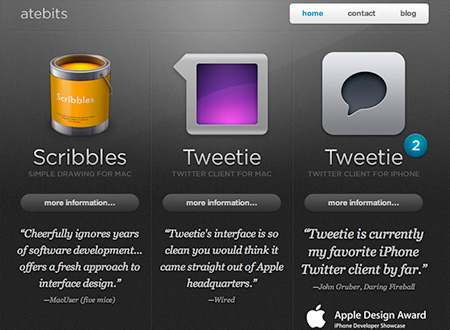04.16.12 |
∞
Developer Dan Shipper:
When a non-technical person attempts to estimate software development time they come armed with their two basic heuristics: complexity based on size and complexity based on speed. But what they don’t realize is that software is different. Software is by nature not physical. It exists in the ether. A tiny portion of it shows up on our computer screens from time to time. Because of this when it comes to building web apps (or any type of software for that matter) our basic heuristics break down.
So many tech articles include a throwaway sentence on how developers aren’t good estimators of their work time. Rarely do they go further into the why behind that statement, but Dan’s does, and does so effectively. (via Watts Martin)
04.10.12 |
Technology |
∞
I was initially as shocked as everyone else when I heard the news of Facebook spent $1 billion to pick up Instagram. But then it came together in my mind: Instagram’s purchase is major win for great mobile design, for online products with high engagement and fast code.
None of those things make sense at first glance. Instagram is a photo sharing app without a proven business model or positive revenue. A company of thirteen (!) employees who’s majority share of 30 million plus users are already Facebook members. A social network that at its core isn’t groundbreaking; sharing photos on a wide scale has been done with Flickr since 2004.
But the deal did happen, and there’s there’s several standout lessons here for designers and developers rooted in the reason why:
If you create a product with very high levels of engagement, you can be a threat to some of the largest tech companies out there. Facebook saw people shifting their mobile time away from Facebook to apps like Instagram and wanted in. Instagram just has a certain cache, or ‘stickiness’ with their app. For now at least, when influencers want a ‘cool’ way of sharing photos, Facebook and Flickr often aren’t their first choice. Instagram is.
Why? Great engagement derives from unique, emotionally driven design. Granted, part of Instagram’s engagement comes from marketing and sheer luck. Nevertheless, Instagram’s design is standout. For example, other apps use photo filters, but not with the same range, fun naming convention or ease of use to jump between them; Instagram makes post processing fun. It’s been one and a half years since Instagram’s debut, yet how many other apps can make that same claim?
High engagement levels can be retained with simple, straightforward design. Instagram was one of the first apps to make sharing to multiple social services so damn easy. It doesn’t take many more steps than your typical iPhone shot: capture, pick a filter, pick who to share to and you’re done in three taps.
High engagement is generally maintained only from a quick, responsive app or platform. This is where blazing performance at the development level comes in. Earlier in the year an in-house engineering blog post revealed some of Instagram’s tech under the hood. It’s straightforward, well thought out and was able to scale to 14 million in a year.
Nevertheless, a lot of positives about this deal can’t stop skepticism on my part. I don’t trust Zuckerberg’s claim that sharing with non-Facebook social networks will remain unaffected. Facebook has reneged on its promises repeatedly and likes a tightly controlled ecosystem. I’m thus also worried about the app’s “independent” future long term.
Overall, for a company of Facebook’s size, 1 billion isn’t crazy, “we’re in a bubble” cash. It’s a buy with stellar engagement levels and a mobile weapon to keep away from the other big tech players: Google, Amazon, and Apple. Given the stakes in this arms race between these four companies, don’t be surprised if the numbers only ramp up in upcoming years.
04.05.12 |
∞
Great idea by developer David Kaneda. Totally should come in handy during my cross browser testing phases.
04.05.12 |
∞
Programmer James Hague:
When I sit down to work on a personal project at home, it’s much simpler. I don’t have to follow the familiar standards of whatever kind of app I’m building. I don’t have to use an existing application as a model. I can disregard history. I can develop solutions without people saying "That’s not how it’s supposed to work!"
That freedom is huge.
Having recently knocked out some side projects of my own recently, James really hits it on the head. If you’re a developer and don’t have the time space to go off and run with your own thing on your own time, you’re missing a big growth opportunity.
09.23.11 |
Work |
∞
Web development is constantly evolving, rewarding those that learn and adapt; developers that cling to older methods do so at their own risk. Yet the industry’s heavy workload and tight deadlines place many in a paradoxical situation: Due to their proven and familiar status, older techniques and programs often stay at the forefront of a developer’s workflow.
So how does a web developer learn and evolve while still making their deadlines? Having been in the industry for nine years, recently shifting into a position where I’ll be mentoring junior developers more often, I’ve been reflecting on that question a lot.
Continue reading…
11.16.09 |
Web/UI Design |
∞

Grid based design has been taking the web design world by storm. As evidenced from the sheer amount of resources and conferences with big name designers extolling its benefits in the past year, it may be reaching its zenith of influence. I’ve become a firm believer in a grid based approach to web design, and it’s my hope that with the opinions and resources I’ve compiled below, you will be too.
Continue reading…
